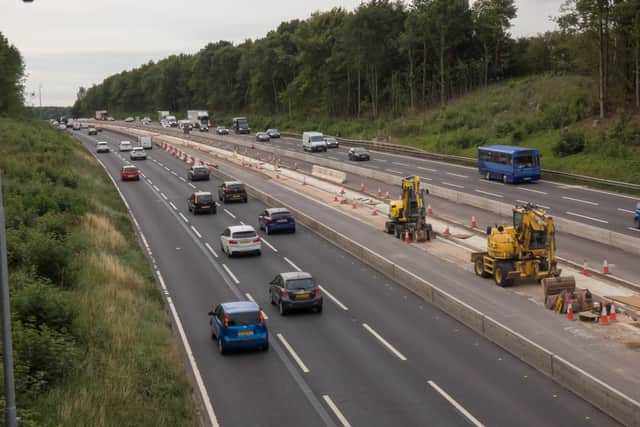Smart motorways ‘undermined’ as half of drivers avoid inside lane over crash and traffic concerns
and live on Freeview channel 276
Half of British drivers avoid using the inside lane on smart motorways, according to a new study.
A survey revealed that fear of encountering a stationary vehicle was the main reason drivers avoided lane one on all lane running (ALR) motorways. The RAC said the revelation “completely undermines” the point of the smart motorway system.
Advertisement
Hide AdAdvertisement
Hide AdALR smart motorways are designed to increase road capacity by turning the hard shoulder into another live traffic lane and installing emergency refuge areas. These are supposed to work alongside stopped vehicle detection systems which can identify a vehicle broken down in a live lane and use overhead signs to close that lane.
However, the RAC survey of drivers found that 49% of motorists “frequently or occasionally” avoid using lane one, with 77% citing the fear of encountering a stopped vehicle where there is no hard shoulder. Forty per cent also said that they feared being crashed into if they were forced to stop in the live lane.
While safety fears were chief among drivers’ reasons for not using the innermost lane, more than half (52%) also said that lane one was usually full of HGVs and using it would require them to frequently overtake. SImilarly 38% said traffic in lane one is usually going much slower than 70mph. A lazy 18% claimed it was just “easier” to drive in lanes two, three and four.
RAC road safety spokesperson Simon Williams said the latest findings showed drivers still lacked confidence in smart motorways. He commented: “Our latest research worryingly shows that half of drivers actively avoid using the inside-most lane for a variety of reasons, not least the fear of being crashed into, meaning much of the extra carriageway capacity smart motorways were meant to bring is wasted.
Advertisement
Hide AdAdvertisement
Hide Ad“Motorists know they should always drive in left-most lane they can, but with so many feeling theirs and their passengers’ lives are in jeopardy, it’s going to be very hard to convince them otherwise no matter how much extra safety technology is introduced.”
Work on new smart motorway projects has been suspended while more safety information is gathered but schemes already under construction when that policy was announced in January are still going ahead. The government continues to favour ALR but a separate study by the RAC found 70% motorists were more in favour of a dynamic hard shoulder system where the hard shoulder could be opened and closed as a live lane depending on traffic conditions.


Recent work to improve existing smart motorways includes the installation of stopped vehicle detection radar systems on all existing stretches of ALR road and new cameras which can catch vehicles ignoring the red X lane closed warnings were installed alongside extra signs showing the distance to the next emergency refuge area. However, Mr Williams said drivers were still reliant on too many separate conditions to give them confidence that ALR roads were safe and urged the government to consider adopting dynamic hard shoulders as the norm
He said: “Stopped vehicle detection cameras are a definite step in the right direction, but they still require National Highways staff to check the carriageway and switch on the ‘red X’ closed-lane signs. Then drivers have to be fortunate enough to see them on gantries or signs – which are often up to 1km apart – in the first place, and hope that all other motorists obey them by moving to another lane. That’s a lot of separate things that have to happen in order to help protect a driver who has broken down, all of which are only necessary because of the decision to remove hard shoulders.
Comment Guidelines
National World encourages reader discussion on our stories. User feedback, insights and back-and-forth exchanges add a rich layer of context to reporting. Please review our Community Guidelines before commenting.
